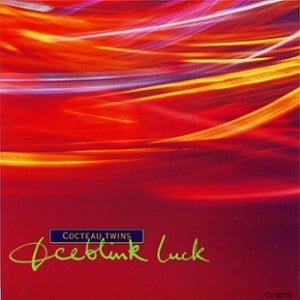
In the early 80s, the Cocteau Twins invented an ethereal pop hybrid with a throw-out-the-rulebook post-punk ethos and a gift for swirling gothic ambience: all ripply underwater basslines, and the nonsensical (and often wordless) but lovely (in a brittle sort of way) vocals of lead singer Elisabeth Fraser; sounds that were paired with appropriately evocative-bordering-on-gibberish song titles (“Pearly Dewdrops’ Drops”) and album cover art (by Vaughan Oliver/23 Envelope, whose work is as synonymous with the Cocteau Twins as Roger Dean’s is with Yes) that was beautifully and tantalizingly non-representative. (What is that black stuff on the cover of The Pink Opaque? Tar? Leather? Water?) A Cocteau Twins record wasn’t just a collection of songs – it was an art object.
Still, by mid-decade, it seems that they had painted themselves into a musical corner, and their albums were increasingly devoid of ideas and drifting off into new age banality. With their 1988 album, Blue Bell Knoll, their first to be picked up by a major U.S. label, the group flirted with a more radio-friendly pop sound. The band’s melodies were still doodly and Fraser’s vocals, while never prettier, were just as indecipherably abstract as ever; but the beats were bigger and the guitars – especially the bass – felt more concrete. Two years later, the group made a jarring leap into straightforward pop with their 1990 album Heaven or Las Vegas. For the first time ever, Fraser was singing words and phrases that actually meant something when you strung them together; meanwhile the melodies were less flighty, more singable, and the production was all shiny surfaces. The album’s lead single was “Iceblink Luck”, probably the happiest song the band ever recorded. Though, of all their songs, it’s probably (by design) the one that came closest to hitting the U.S. pop charts, this is one of those cases where a conscious “selling out” also resulted in an improbable artistic peak.
